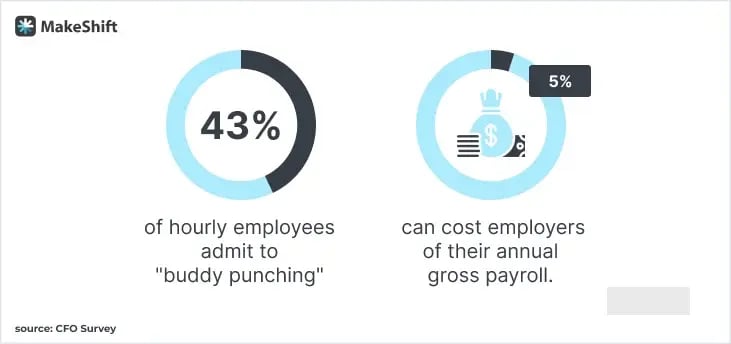Managing employee timesheets can be a daunting task.
Especially if you still rely on manual methods like pen and paper or sharing spreadsheets.
Fortunately, with today’s technology, you’ve got software and digital tools available to streamline and automate the time-tracking process.
You'll reduce errors plus save time and resources when you ditch manual timesheets in favor of software.
It’s time to ditch the “old school” way of managing your staff’s time.
Keep reading to learn how to spend less time and effort on employee timesheets while boosting efficiency and accuracy.
- Download Our Free Employee Timesheet Template
- What Is an Employee Timesheet?
- 7 Problems With a Manual Employee Timesheet System
- How To Effectively Manage Employee Timesheets
- Employee Timesheet Software Checklist
- How to Implement Employee Time Tracking Software
- MakeShift Lets You Ditch Employee Timesheets For Good
- Frequently Asked Questions
Download Our Free Employee Timesheet Template
If you found this article while searching for a free employee timesheet template and that’s all your heart desires, fret not.
We have a gift for you.
Download this employee timesheet template and use it as your own.
If, at some point, you’d like to find out more about streamlining your employee timesheet system, bookmark this article and come back to visit.
What Is an Employee Timesheet?
An employee timesheet is a log of hours worked by an employee over a certain period, usually a week or a month.
Timesheets can be used for various purposes, including:
- Tracking employee attendance & hours worked
- Calculating payroll
- Managing project budgets
They can be filled out manually or electronically or submitted through software (our favorite method).
They’re used in many industries — healthcare, finance, construction, retail, etc.
Timesheets are essential to ensure accurate and compliant payroll and monitor employee performance.
Paper or spreadsheet timesheets can be handy for tracking employee time.
But unfortunately, they come with a plethora of potential problems that can impact accuracy, efficiency, and compliance.
7 Problems With a Manual Employee Timesheet System
When we refer to a “manual’ work timesheet, we’re talking about an old-school paper timesheet, a spreadsheet, or a clock-in system only accessible at work.
All 3 had their day in the sun but don’t cut it now because of the problems they bring to the party.
1. Human Error
The risk of human error is high when using paper or spreadsheets to log employee time — people regularly make mistakes while entering their hours or calculating their time.
Those mistakes are time-consuming to find and fix.
For example, a team member might space clocking in or out or accidentally type in the wrong time, leading to inaccurate data.
QuickBooks says over 80% of manual employee timesheets must be corrected.

2. Abundant Limitations
Paper has to be physically handled, turned in, and can easily be lost — need we say more?
The problem with using shared spreadsheets for employee timesheets is they can be slow, glitchy, and prone to errors, like incorrect calculations or accidental deletion.
In addition, they may not provide adequate security and privacy for employee info.
The problem with a manual clock in and out system?
It can be prone to errors, like forgetting to punch in or out, and may require significant administrative effort to process and calculate payroll manually.
3. Time-Consuming
Manual employee timesheets can be time-consuming, especially if your employees have to fill them out by hand or navigate a clunky, complicated spreadsheet.
With this method, finance or HR has to wade through paper or spreadsheets every pay period, reviewing for signatures and accuracy.
That’s a colossal waste of time.
4. Lack of Real-Time Data
Manual timesheets often contain outdated data that’s far from real-time tracking, making it difficult for managers to make informed decisions.
For example, a manager might not know if an employee is running late or has called out sick until they see the timesheet at the end of the week, which can affect productivity and workflow.
5. Increased Buddy Punching
Paper timesheets and manual clock in/out methods increase the risk of buddy punching and time theft. Employees can easily pad their hours or punch in a coworker.
For example, an employee might roll in 20 minutes late for work, but not subtract that on their timesheet.
Who’s to know?
According to a Software Advice study, 43% of hourly employees admit to "buddy punching." Did you know buddy punching can cost you up to 5% of your annual gross payroll?

6. Compliance Issues
Manual employee timesheets can create compliance issues because certain industries require specific timekeeping practices to comply with regulations.
For example, a hospital might require employees to track their time to ensure accuracy and avoid legal issues.
7. Integration Woes
Manual timesheet systems don’t easily integrate with other systems, like payroll or HR systems, which creates added work for managers or HR staff.
For example, a payroll administrator might have to input data from each timesheet into a payroll system manually. This is a drain on time and ups the risks of potential errors.
Companies that use manual timesheets spend an average of 3.2 hours per pay period transferring employee time data to their payroll system.
However, companies using automated time-tracking software only spend an average of 1.5 hours per pay period on this task — a time savings of 53%.

How To Effectively Manage Employee Timesheets
Managing your staff’s timesheets most effectively is crucial to your workforce optimization and company culture.
To be effective, you need to be direct. To be efficient, you need a plan.
1. Set Expectations
Set clear deadlines and expectations for when, where, and how timesheets are due.
Let your staff know that’ll help prevent payroll delays and improve accuracy.
Address these questions:
- When & where should staff submit timesheets?
- How should they tag each entry?
- How do they round uneven times?
- How should they track client time?
- How will you track and pay for overtime?
2. Monitor and review timesheets regularly
Monitor and review timesheets regularly to catch any errors or discrepancies early, reducing the time and effort required to correct them later.
Regular review can also help you identify trends or issues in employee attendance or performance that may require further investigation or intervention.
3. Address any discrepancies or issues promptly
Promptly address timesheet discrepancies or issues to ensure accurate and timely payroll processing and maintain compliance with labor laws and regulations.
Promptly addressing issues can also help maintain team trust and morale. Your employees may become frustrated or jaded if their paychecks are regularly inaccurate or delayed.
Thoroughly investigate any discrepancies or issues.
Do your best to resolve them promptly and appropriately, abiding by company policies and applicable labor laws and regulations.
4. Streamline the process with software
Using software for timesheet management can help streamline the process and save serious time and effort for both employees and managers.
Employees who use manual timesheets spend about 4.6 hours completing their time cards every period.
This includes:
- Time spent tracking hours worked
- Calculating pay
- Submitting time cards to their supervisor.
In contrast, employees using automated time-tracking software spend an average of 2.5 hours per pay period on these tasks. That’s 45% less time!
Software also provides real-time visibility and tracking of employee attendance and performance, which can help you make informed decisions and identify areas for improvement.
Employee Timesheet Software Checklist
When choosing timesheet software, consider the features most important for your specific needs — like the ability to clock in on employee phones, payroll integration, and HR systems, and support multiple locations and time zones.
Use this feature checklist as a guide:
- Mobile Access
- Geofencing
- Automatic wage calculations
- Payroll integration
- Automatic notifications
How to Implement Employee Time Tracking Software
Once you’ve selected your software, provide adequate training and support to employees and managers to ensure a smooth transition and adoption.
Explain the benefits of time tracking software for your employees (some may see this more as a way to micro-manage). Promote the benefits of flexibility and payroll accuracy of using software
Give grace for the learning curve.
Finally, continuously monitor and evaluate the effectiveness of the software, and tweak it as needed to optimize its performance and value.
MakeShift Lets You Ditch Employee Timesheets For Good
MakeShfit offers a Time & Attendance add-on to streamline the process so you can bid adieu to manual timesheets.
Enjoy smarter scheduling and timesheet management that requires less time and makes employees much happier.
Our all-in-one solution creates cohesiveness and smooth workflows by offering:
Easy Clock-In
Accurately track employee time by allowing them to clock in and out from their phones or an on-site device.
Use geofencing to confirm employees are on-site when clocking in and out for their shifts and breaks.
- Quick clock-ins from the employee mobile app
- Photos on time punches to prevent "buddy punching”
- Location-based clock-ins

Accurate Timesheets
Manage your employee timesheets based on clock in and out entries and quickly approve and export to payroll.
- Managers approve and close timesheets
- Automate wage calculations based on payroll rules
- Payroll exports to payroll providers

Manage on-the-go
With MakeShift Live, our mobile app for managers, you can quickly see who’s on shift or on break, and easily adjust time entries, if needed.
- Daily schedule view of shifts compared to clock-ins
- Adjust employee time entries
- See who’s working and who’s out
.png?width=1200&height=1200&name=unnamed%20(2).png)
Managing Employee Timesheets Doesn’t Have to Be a Pain
Sure, as long as you have a business, you’ll have to manage work timesheets. Your business depends on accurate payroll and happy, productive employees.
But there’s no need to try to manage timesheets manually.
Claim back your time and make it easy on yourself and your staff with scheduling and time and attendance software.
Talk to one of our MakeShift consultants or schedule a free demo to see how we can help you.
Frequently Asked Questions
How do you manage employee timesheets?
- Establish clear guidelines & consequences for timesheet submissions.
- Provide employee training & support for those who need help with the process.
- Regularly review and audit timesheets for accuracy and compliance.
- Use a time-tracking app or software to automate the process & reduce errors.
How do you keep track of timesheets?
In addition to using a time-tracking app & having clear submission guidelines, you can keep track of timesheets by assigning a manager or supervisor to oversee the process. Set up a reminder system for employees to submit their timesheets and provide regular feedback & support to ensure compliance and accuracy.
How do I get my employees to track their time?
To get your employees to track their time:
- Set clear expectations & consequences for non-compliance
- Provide training and support for the time-tracking process
- Emphasize the importance of accurate and timely reporting for project management and getting paid on time.
How do you create an employee timesheet template?
To create an employee timesheet template, you can use a spreadsheet program like Microsoft Excel or Google Sheets.
Include columns for:
- Date, start & end times
- Total hours worked,
- Any relevant project or task codes
Customize the template to fit your company's specific needs and requirements.
OR — download our free employee timesheet template








